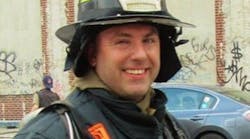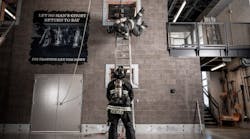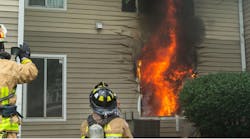TOPIC: EVALUATING FIREFIGHTER PROFICIENCY
TIME REQUIRED: SIX HOURS
MATERIALS: PERSONAL PROTECTIVE CLOTHING AS REQUIRED FOR EACH EVOLUTION
REFERENCES: ESSENTIALS OF FIRE FIGHTING, FOURTH EDITION, IFSTA
PREPARATION:
MOTIVATION:
OBJECTIVE (SPO): 1-1
The individual or team will demonstrate an ability for performing basic fire fighting skills by successfully completing each of the skill stations in a safe manner.
OVERVIEW:
EVALUATING FIREFIGHTER PROFICIENCY
* Evaluate Performance
EVALUATING FIREFIGHTER PROFICIENCY
SPO 1-1 The individual or team will demonstrate an ability for performing basic fire fighting skills by successfully completing each of the skill stations in a safe manner.
EO 1-1 Working individually or as a member for a designated team, successfully complete each of the basic fire fighting skills in a safe and efficient manner.
This drill is designed to provide an opportunity for the fire department leadership to evaluate the basic fire fighting skills of their personnel through the performance of specified evolution. The results of this evaluation can be the basis for identifying future training activities. It is expected that the individual or team will complete each evolution in a safe and efficient manner. Items to consider during the evaluation are included with each item. The referenced text will be used as a guide for evaluating performance. Each evolution should be performed in full protective clothing with eye protection required for some evolutions.
I. EVALUATE PERFORMANCE (1-1)
A. Select the tools and explain or demonstrate the procedure for making entry through a double hung window with multiple panes with minimal damage.
1. Select an axe or haligan bar
2. Using the forked end of the haligan bar, attempt to pry at the bottom of the window, forcing the
bottom section upward. The lock should come apart at this point.
3. If an axe is selected, place the blade of the axe underneath the bottom section of the window and
lift the handle upward or downward to change the position of the blade. The lock should come
apart at this point
4. As an alternative, break out a pane of glass, clear the opening of any remaining glass, and reach in
and unlock the window
B. Select the tools and explain or demonstrate the method for making entry through a single metal covered fire door equipped with a mortise lock with minimal damage.
1. Select an axe, haligan bar, and K-tool
2. Place the K-tool on the lock cylinder
3. Place the adz end of the haligan bar in the stirrup of the K-tool and tap the K-tool securing in place
with the back of the axe
4. Push down on the haligan bar until the lock cylinder begins pulling out.
5. Continue to pull until the lock cylinder is removed
6. Insert the proper key tool into the opening where the lock cylinder was removed and unlock the
door
7. As an alternative, if the door is pushing in, insert a rabbit tool between the door and the jamb near
the lock.
8. Operate the rabbit tool until the lock is opened
C. Identify the major parts of a positive pressure self-contained breathing apparatus.
1. Identify the cylinder
2. Identify the backpack assembly
3. Identify the shoulder straps
4. Identify the waist strap
5. Identify the regulator (both stages if so equipped)
6. Identify any controls on the regulator
7. Identify the PASS device (integrated or separate)
8. Identify the facepiece
D. Don and put into operation a positive pressure self-contained breathing apparatus within 1 minute while attired in full personal protective clothing (coat, pants, hood, helmet, boots, and gloves).
1. Conduct pre-donning inspection to make sure all the straps are let out and the high pressure hose
connection is secure
2. Don the unit using either the coat or over-the-head methods, or removal from a mounting bracket
3. Don the facepiece, securing all straps in the proper sequence
4. Check the facepiece for a seal
5. Turn on the cylinder
6. Connect facepiece to regulator and begin breathing air
7. Make sure all protective clothing is being worn properly and no skin is exposed
8. Make sure there are no air leaks
E. Identify the hydrostatic test date on a positive pressure self-contained breathing apparatus cylinder and refill the cylinder to the appropriate pressure using a cascade system.
1. Make are connections between the cylinder and the cascade system
2. Open cylinder valve
3. Note pressure reading in cylinder
4. Open cascade cylinder with pressure greater than SCBA cylinder
5. Continue process until pressures are equalized and cylinder is full
6. Close cylinder valve and bleed pressure before disconnecting high pressure hose line from cylinder
7. Consider the use of a protective device in which to secure the cylinder during filling operations
8. Consider filling the cylinder slowly to reduce heat buildup
F. Demonstrate the method for checking the condition of lifeline rope and explain what is being checked.
1. Inspect at least every three feet
2. Look for discoloration, melting of fibers, cut or damaged fibers, potential chemical damage, or
apparent stress of the material
G. Tie a bowline, clove hitch, half hitch, figure eight on a bight, becket bend, and safety knot, all within 2 minutes.
H. Hoist a pike pole, haligan bar, smoke ejector, and roof ladder to a height of at least 20 feet using the proper knots and safety practices.
1. Tie a clove hitch around the end of the pike pole and one or two half hitches on the pole with the
last one being at the hook
2. Tie a clove hitch, around the haligan bar near the fork, pass the rope through the fork, and tie a half
hitch under the adz/point end
3. Tie a bowline through the handles of the smoke ejector
4. Form a bowline or figure eight on a bight that is big enough to go around the beams of the ladder,
run the knot down the ladder about one-third of its length, pass the knot through the rung and back
up the underside of the ladder until it reaches the tip, pass the knot over the tip, and take up the
slack in the rope
I. Working alone, cover an arrangement of furniture using a salvage cover which has been folded in a one-person fold.
1. Place the furniture in a pile with consideration to protecting breakables and keeping items easily
damaged by water off the floor
2. Place the cover on the top of the pile and proceed to unfold it
3. Tuck the ends under the pile of furniture
J. With the assistance of another firefighter, fold a salvage cover for one-person usage.
K. Explain the application and operation of a double male, double female, gated wye, siamese, fog nozzle, and solid stream nozzle.
L. Using a modified flat load, pull and advance a pre-connected 150-foot, 1-1/2-inch, 1-3/4-inch, or 2-inch attack line. Once pulled, demonstrate the position on the nozzle and application of the water for interior firefighting using the direct method of attack.
1. Hose should be pull so that there is adequate hose near the point where the nozzle is to be used
rather than all the hose being piled near the apparatus
2. Person on nozzle should be a kneeing position
3. One hand should be securing the hose while the other hand is controlling the nozzle shutoff and
pattern
M. Lay out and charge a 3-inch, 4-inch, or 5-inch supply line using a hydrant valve.
1. Hydrant valve is connect to steamer connection on hydrant
2. Supply line is point in direction of hose lay
N. Advance 150 feet of pre-connected 2-1/2-inch hose (uncharged) up an extension ladder. Exit the ladder onto a roof or in a window and secure the hose to the ladder.
1. Hose is under arm, across chest, with nozzle over shoulder of person advancing hose
2. Individual steps off ladder on same side as hose is draped
3. Sufficient hose is taken to reach target
4. Hose is secured to ladder with rope hose tool or hose strap
O. Connect a section of 2-1/2-inch or 3-inch hose with 2-1/2-inch couplings to a section of 1-1/2-inch, 1-3/4-inch, or 2-inch hose with 1-1/2-inch couplings.
1. Reducer is placed on male connection first
2. Female hose connection is fastened to reducer
P. Working with another firefighter, lift, carry, and raise a 24-foot extension ladder. Once raised, each person should climb, take a leg lock, and foot the ladder alternatively.
1. Firefighters work as a team
2. Firefighter at heel gives initial commands
3. Ladder is advanced to building heel end first
4. Heel is spotted approximately one-quarter working length from building
5. Heel is placed on ground
6. Firefighter at heel assumes position to foot ladder by squatting with feet on bottom rung
7. Ladder is raised to a vertical position with firefighter on outside of ladder watching for overhead
obstructions
8. Firefighters reposition on ladder so that firefighter on inside of ladder has side of one foot and one
shoulder against one beam while other firefighter has one foot against same beam and is holding
both beams with hands
9. Halyard is pull by firefighter on inside of ladder to extend fly section
10. Firefighter on outside of ladder determines correct extension
11. Once raised to proper height, firefighters reposition for lowering into building
12. Firefighter on outside of ladder assumes footing position with one foot on bottom rung
13. Firefighter on inside of ladder keeps back straight and arms outstretched
14. Ladder is lowered slowly into building
15. Angle of ladder is checked by standing on bottom rung with arms outstretched so that palms rest
comfortably on rungs
16. Adjustments are made as needed to achieve proper angle
17. Before climbing, halyard is secured and dogs are checked to make sure the have both engaged
18. Ladder is footed by standing on underside of ladder and holding onto beams
Q. Working with two other firefighters, lift, carry, and raise a 35-foot extension ladder.
1. Firefighters work as a team
2. Firefighter at heel gives initial commands
3. Ladder is advanced to building heel end first
4. Heel is spotted approximately one-quarter working length from building
5. Heel is placed on ground
6. Firefighter at heel assumes position to foot ladder by squatting with feet on bottom rung
7. Ladder is raised to a vertical position with firefighters on outside of ladder watching for overhead
obstructions
8. Firefighters reposition on ladder so that firefighter on inside of ladder has side of one foot and one
shoulder against one beam while other firefighter has one foot against same beam and is holding
both beams with handsThird firefighter is positioned against other beam with toe against side of
beam and both hands on beam
9. Halyard is pull by firefighter on inside of ladder to extend fly section
10. Firefighter on outside of ladder determines correct extension
11. Once raised to proper height, firefighters reposition for lowering into building
12. Firefighters on outside of ladder assumes footing position with inside foot on bottom rung
13. Firefighter on inside of ladder keeps back straight and arms outstretched
14. Ladder is lowered slowly into building
15. Angle of ladder is checked by standing on bottom rung with arms outstretched so that palms rest
comfortably on rungs
16. Adjustments are made as needed to achieve proper angle
17. Before climbing, halyard is secured and dogs are checked to make sure the have both engaged
18. Ladder is footed by standing on underside of ladder and holding onto beams
R. Working alone, demonstrate carrying a roof ladder up an extension ladder and placing it on a roof.
1. Roof ladder is carried to location heel first
2. Roof hooks are opened before ladder is taken up extension ladder
3. Firefighter is positioned near center of roof ladder with upper beam on shoulder
4. As firefighter nears the top of the ladder, the roof ladder is sled on the roof on its lower beam
5. As the firefighter reaches the top of the ladder, a leg lock is taken
6. The roof ladder is then sled so that the hooks are at the peak of the roof
7. The ladder is then laid flat so that the hooks can engage against the peak
8. The firefighter tugs on the roof ladder to make sure the hooks are secured against the roof
S. Working alone, bring a simulated unconscious victim down an extension ladder from a height of at least 15 feet.
1. The victim is placed on the firefighter’s knee with the victim facing the ladder
2. The firefighter placed both arms under the arms of the victim, with the hands on the rung while
protecting the victim’s face
3. The firefighter proceeds to slide the victim down the ladder, alternating knees in the victim’s crouch
region
T. Working with another firefighter, conduct a search of a small room such as a bedroom filled with simulated or real smoke, and locate and remove any victims or simulated victims found.
1. Firefighters mark down to denote entrance
2. Firefighters turn same direction at all times to maintain orientation
3. Firefighters check under and on top of objects and in various parts of the room
4. Firefighters locate and remove any victims found using methods that do not harm victim (consider
clothing or blanket drag)
5. Firefighters able to remove victim using point of entry
U. Demonstrate the placement of a positive pressure blower for removal of smoke from an interior room.
1. Firefighters position blower six to ten feet from entrance
2. Firefighters check to ensure that cone of air is covering as much of entrance as possible and
reposition as needed
V. Explain the operational procedure for venting a house to relieve a backdraft condition.
1. Firefighter indicates signs that might indicate a backdraft condition
2. Vertical ventilation accomplished at highest point directly over fire
W. Demonstrate the method of carrying and using the axe, pike pole, pressurized water fire extinguisher, and haligan bar.
1. Axe is carried with blade under arm if flathead axe; point covered with hand if pick head axe
2. Cutting done on slight angle with cuts being made away from body
3. Pike pole carried with point forward and pointed downward
4. Pike pole inserted into material to be pulled, hook pointed away, and pull made downward and
away from firefighter (when pulling ceiling, start in doorway and work into room)
5. Pressurized water extinguisher carried using carrying handle
6. Extinguisher taken to place of usage, pin pulled, nozzle aimed at base of fire, operating lever
squeezed, and water discharged on fire
7. Haligan bar carried with adz/point forward and slightly downward
8. Adz end used for chopping or prying, forked end used for prying, and point used for punching
holes
NOTE: All tools and appliances will be at the appropriate station and will not need to be removed from the apparatus. All the skills identified are required of a Firefighter I under NFPA Standard 1001, Fire Fighter Professional Qualifications, 1997 Edition.
REVIEW:
EVALUATING FIREFIGHTER PROFICIENCY
* Evaluate Performance
REMOTIVATION: Safe and efficient performance of basic fire fighting skills on the emerency scene are vital to the overall outcome of the incident. With the decrease in the number of incidents where skills may be used, it is important that individuals maintain their skills proficiency. The incident scene is not the place for refresher training.






